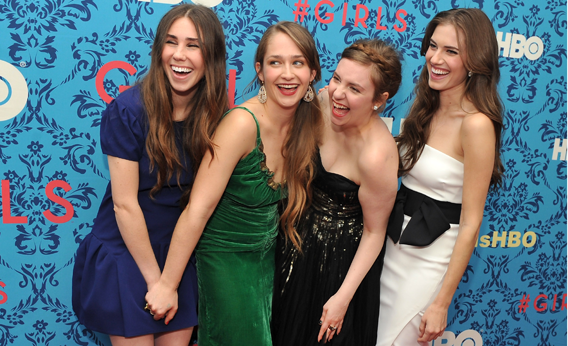The second season of Lena Dunham’s HBO sitcom Girls doesn’t premiere until Sunday, but in some quarters the knives are already out and sharpened for the show, which last season became a veritable dartboard, stuck full of charges that it was everything from racist to toxically self-absorbed. No show, including Girls, is immune from critique. And I agree that the first season was bizarrely white for a show set in Brooklyn. I also wish Lena Dunham hadn’t hired Lesley Arfin, a wannabe-provocateur who responded to well-reasoned critiques of the show’s race politics with astonishing immaturity and racist jokes. But there’s something about Girls that seems to drive critics a little nuts, inspiring them to pick up slings and arrows that ought to be aimed at the television industry as a whole and use them instead solely against Dunham.
At the New York Post, Linda Stasi let loose an impressively nasty review of the second season, bringing up Hollywood’s obsessive standards about women’s bodies as an excuse to express her disgust for Dunham’s. While many writers have insisted that what bothers them about Girls is the degrading positions (sexual and otherwise) its characters find themselves in, Stasi both complains about those circumstances, and makes it clear she’s disgusted with Dunham herself: “It’s not every day in the TV world of anorexic actresses with fake boobs that a woman with giant thighs, a sloppy backside and small breasts is compelled to show it all,” she wrote. “It’s a boon for the out-of-shape, and perhaps a giant economic loss for high-end gyms, especially in Brooklyn.” Reactions like Stasi’s—and the presumption that the primary and most important function of any woman who appears on screen is to be sexually attractive to the audience—are exactly why it’s rare to see bodies like Dunham’s on television.
Over at Jezebel, Anna Breslaw gets up in arms about the fact that Girls has earned a number of promotional tie-ins in its second season, from costume designer Jennifer Rogien’s gig consulting for Aerie, to nail art offered through Urban Outfitters. She’s not wrong that “the tone of Girls is refreshing because it lacks precisely that kind of consumer-driven, I’m-supposed-to-want-her-purse aspirational shit that lurks in the background of basically every other female-driven show on television.” But she’s missing that tie-ins are a way to make a low-rated show like Girls economically viable, or even to earn a bigger budget for it—and the fact that plenty of male-centered shows have tie-ins, too. FX’s biker gang drama Sons of Anarchy, for instance, has licensing deals with Harley Davidson, even though its characters would have nothing but disgust for people who buy their way into the biker lifestyle instead of earning their gang regalia. If this is part of the economic model of television, I’d much rather have outside tie-ins than be forced to see Marnie cooing over Christian Louboutin shoes every fourth episode.
There’s no question that television has big problems with everything from body image, to product placement, to the shocking whiteness of the writers’ rooms where scripts are turned out. And I wish that more pop culture fans approached their television and movies the same way that foodies do, with concern for how the products are produced. But I’d like to see a little consistency: If critics are going to turn against Lena Dunham, I want to know why they aren’t mad at Louis C.K.’s sloppy backside, too.
